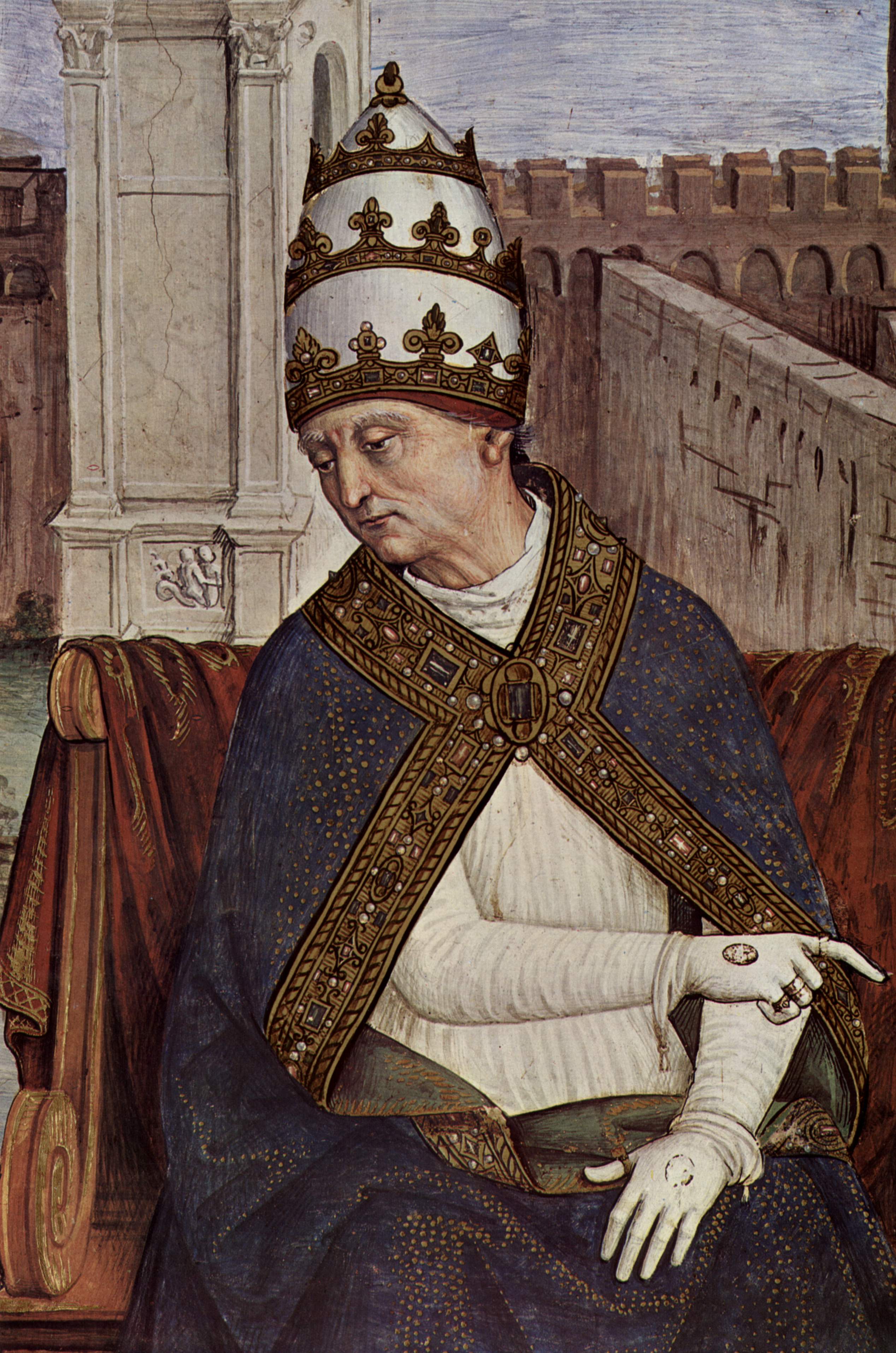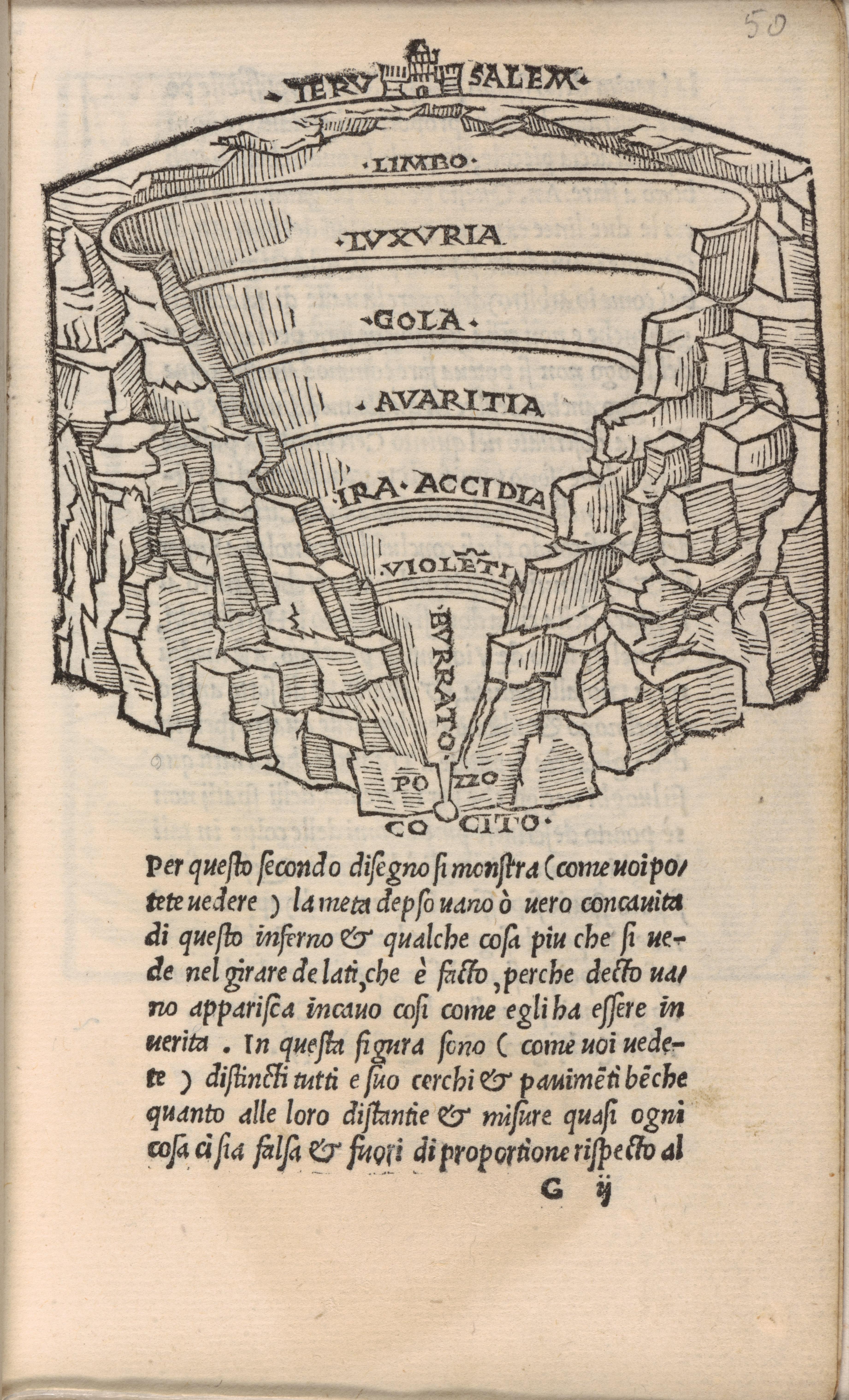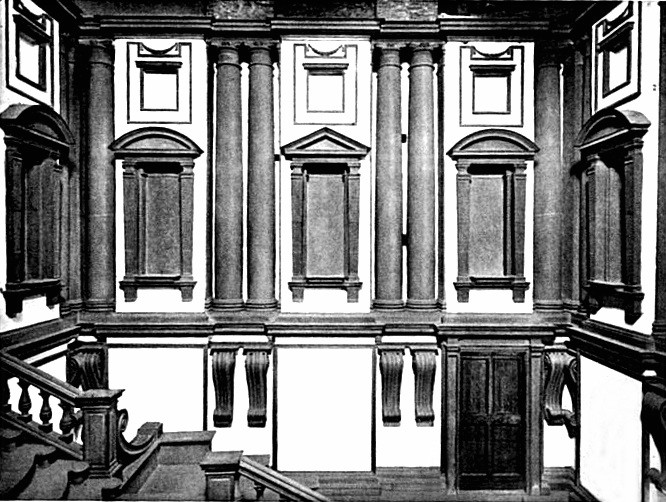|
San Lorenzo, Florence
The Basilica di San Lorenzo (Basilica of St. Lawrence) is one of the largest churches of Florence, Italy, situated at the centre of the main market district of the city, and it is the burial place of all the principal members of the Medici family from Cosimo il Vecchio to Cosimo III. It is one of several churches that claim to be the oldest in Florence, having been consecrated in 393 AD, at which time it stood outside the city walls. For three hundred years it was the city's cathedral, before the official seat of the bishop was transferred to Santa Reparata. San Lorenzo was the parish church of the Medici family. In 1419, Giovanni di Bicci de' Medici offered to finance a new church to replace an eleventh-century Romanesque rebuilding. Filippo Brunelleschi, the leading Renaissance architect of the first half of the fifteenth century, was commissioned to design it, but the building, with alterations, was not completed until after his death. The church is part of a larger monast ... [...More Info...] [...Related Items...] OR: [Wikipedia] [Google] [Baidu] |
Roman Catholic
Roman or Romans most often refers to: *Rome, the capital city of Italy *Ancient Rome, Roman civilization from 8th century BC to 5th century AD *Roman people, the people of ancient Rome *'' Epistle to the Romans'', shortened to ''Romans'', a letter in the New Testament of the Christian Bible Roman or Romans may also refer to: Arts and entertainment Music * Romans (band), a Japanese pop group * ''Roman'' (album), by Sound Horizon, 2006 * ''Roman'' (EP), by Teen Top, 2011 *" Roman (My Dear Boy)", a 2004 single by Morning Musume Film and television * Film Roman, an American animation studio * ''Roman'' (film), a 2006 American suspense-horror film * ''Romans'' (2013 film), an Indian Malayalam comedy film * ''Romans'' (2017 film), a British drama film * ''The Romans'' (''Doctor Who''), a serial in British TV series People *Roman (given name), a given name, including a list of people and fictional characters *Roman (surname), including a list of people named Roman or Romans *Ῥωμ� ... [...More Info...] [...Related Items...] OR: [Wikipedia] [Google] [Baidu] |
Medici
The House of Medici ( , ) was an Italian banking family and political dynasty that first began to gather prominence under Cosimo de' Medici, in the Republic of Florence during the first half of the 15th century. The family originated in the Mugello region of Tuscany, and prospered gradually until it was able to fund the Medici Bank. This bank was the largest in Europe during the 15th century and facilitated the Medicis' rise to political power in Florence, although they officially remained citizens rather than monarchs until the 16th century. The Medici produced four popes of the Catholic Church—Pope Leo X (1513–1521), Pope Clement VII (1523–1534), Pope Pius IV (1559–1565) and Pope Leo XI (1605)—and two queens of France—Catherine de' Medici (1547–1559) and Marie de' Medici (1600–1610). In 1532, the family acquired the hereditary title Duke of Florence. In 1569, the duchy was elevated to the Grand Duchy of Tuscany after territorial expansion. The Medici ruled the G ... [...More Info...] [...Related Items...] OR: [Wikipedia] [Google] [Baidu] |
Transept
A transept (with two semitransepts) is a transverse part of any building, which lies across the main body of the building. In cruciform churches, a transept is an area set crosswise to the nave in a cruciform ("cross-shaped") building within the Romanesque and Gothic Christian church architectural traditions. Each half of a transept is known as a semitransept. Description The transept of a church separates the nave from the sanctuary, apse, choir, chevet, presbytery, or chancel. The transepts cross the nave at the crossing, which belongs equally to the main nave axis and to the transept. Upon its four piers, the crossing may support a spire (e.g., Salisbury Cathedral), a central tower (e.g., Gloucester Cathedral) or a crossing dome (e.g., St Paul's Cathedral). Since the altar is usually located at the east end of a church, a transept extends to the north and south. The north and south end walls often hold decorated windows of stained glass, such as rose windows, in sto ... [...More Info...] [...Related Items...] OR: [Wikipedia] [Google] [Baidu] |
Chapel
A chapel is a Christian place of prayer and worship that is usually relatively small. The term has several meanings. Firstly, smaller spaces inside a church that have their own altar are often called chapels; the Lady chapel is a common type of these. Secondly, a chapel is a place of worship, sometimes non-denominational, that is part of a building or complex with some other main purpose, such as a school, college, hospital, palace or large aristocratic house, castle, barracks, prison, funeral home, cemetery, airport, or a military or commercial ship. Thirdly, chapels are small places of worship, built as satellite sites by a church or monastery, for example in remote areas; these are often called a chapel of ease. A feature of all these types is that often no clergy were permanently resident or specifically attached to the chapel. Finally, for historical reasons, ''chapel'' is also often the term used by independent or nonconformist denominations for their places of wor ... [...More Info...] [...Related Items...] OR: [Wikipedia] [Google] [Baidu] |
Pius II
Pope Pius II ( la, Pius PP. II, it, Pio II), born Enea Silvio Bartolomeo Piccolomini ( la, Aeneas Silvius Bartholomeus, links=no; 18 October 1405 – 14 August 1464), was head of the Catholic Church and ruler of the Papal States from 19 August 1458 to his death in August 1464. He was born at Corsignano in the Sienese territory of a noble but impoverished family. He was a Renaissance humanist, famous as an author in Latin before he became pope. His longest and most enduring work is the story of his life, the ''Commentaries'', which is the only revealed autobiography ever to have been written by a reigning pope. This was only published in 1584. Early life Aeneas was born to Silvio, a soldier and member of the House of Piccolomini, and Vittoria Forteguerri, who had 18 children including several twins, though most died at a young age. He worked with his father in the fields for some years and at age 18 left to study at the universities of Siena and Florence. He settled in the f ... [...More Info...] [...Related Items...] OR: [Wikipedia] [Google] [Baidu] |
Michelozzo
Michelozzo di Bartolomeo Michelozzi (1396 – 7 October 1472) was an Italian architect and sculptor. Considered one of the great pioneers of architecture during the Renaissance, Michelozzo was a favored Medici architect who was extensively employed by Cosimo de' Medici. He was a pupil of Lorenzo Ghiberti in his early years, and later collaborated with Donatello. Known primarily for designing Palazzo Medici Riccardi in Florence, he is often overshadowed by his contemporaries Donatello in sculpture and Brunelleschi in architecture. Life Early life Michelozzo was born in Florence in 1396. He was the son of Bartolomeo di Gherardo Borgognone and Antonia. Borgognone was of French origin and arrived in Florence from Burgundy at an unknown date. Borgognone lived and worked in the Santa Croce quarter of Florence as a tailor, and was made a Florentine citizen on 9 April 1376. Michelozzo had three brothers named Leonardo (b. 1389/90), Zanobi (b. 1391), and Giovanni (b. 1403). By 1391, ... [...More Info...] [...Related Items...] OR: [Wikipedia] [Google] [Baidu] |
Antonio Manetti
Antonio di Tuccio Manetti (6 July 1423 – May 26, 1497) was an Italian mathematician and architect from Florence. He is particularly noted for his investigations into the site, shape and size of Dante's ''Inferno''. Although Manetti never himself published his research regarding the topic, the earliest Renaissance Florentine editors of the poem, Cristoforo Landino and Girolamo Benivieni, reported the results of his researches in their respective editions of the ''Divine Comedy''. Manetti is also famous for his short story, ''The Fat Woodworker,'' which recounts a cruel practical joke devised by Brunelleschi. Furthermore, his supposed authorship of the biography of Filippo Brunelleschi has been widely discussed and analyzed. Manetti was further a member of the Arte di Por Santa Maria (also known as Arte della Seta), one of the seven Arti Maggiori guilds of Florence. Born to a family of silk merchants, Manetti not only received an excellent education but was confronted with ample f ... [...More Info...] [...Related Items...] OR: [Wikipedia] [Google] [Baidu] |
Matteo Nigetti
Matteo Nigetti (ca. 1560/1570 – 1648) was an Italian architect and sculptor. He is an important Baroque architect in Florence. Biography Born in Florence, he was the pupil and assistant of Bernardo Buontalenti, with whom he collaborated on the Palazzo Nonfinito (1593) (i.e. the ''unfinished palace'', which now houses the National Museum of Anthropology and Ethnology in Florence). Nigetti's masterwork is the Cappella dei Principi ("Princes' Chapel"), part of the church of San Lorenzo in Florence. It was commissioned by Grand Duke Ferdinand I, and Nigetti spent forty years of his life, from 1604 until his death, in its completion. He was assisted by Don Giovanni de' Medici, Ferdinand's half-brother, and Alessandro Pieroni. In parallel, Nigetti was one of the main architects, along with Gherardo Silvani, who produced the church of San Gaetano, Florence, developing an original design by Buontalenti. Nigetti also designed the original façade of the Ognissanti church. His b ... [...More Info...] [...Related Items...] OR: [Wikipedia] [Google] [Baidu] |
Medici Chapels
The Medici Chapels (''Cappelle medicee'') are two structures at the Basilica of San Lorenzo, Florence, Italy, dating from the 16th and 17th centuries, and built as extensions to Brunelleschi's 15th-century church, with the purpose of celebrating the Medici family, patrons of the church and Grand Dukes of Tuscany. The ''Sagrestia Nuova'' ("New Sacristy") was designed by Michelangelo. The larger ''Cappella dei Principi'' ("Chapel of the Princes"), although proposed in the 16th century, was not begun until the early 17th century, its design being a collaboration between the family and architects. These are not to be confused with the Magi Chapel in the Palazzo Medici Riccardi, then the main Medici home, that houses a famous cycle of frescoes by Benozzo Gozzoli, painted around 1459. The ''Sagrestia Nuova'' The ''Sagrestia Nuova'' was intended by Cardinal Giulio de' Medici and his cousin Pope Leo X as a mausoleum or mortuary chapel for members of the Medici family. It balances Bru ... [...More Info...] [...Related Items...] OR: [Wikipedia] [Google] [Baidu] |
Laurentian Library
The Laurentian Library (Biblioteca Medicea Laurenziana or BML) is a historic library in Florence, Italy, containing more than 11,000 manuscripts and 4,500 early printed books. Built in a cloister of the Medicean Basilica di San Lorenzo di Firenze under the patronage of the Medici pope Clement VII, the library was built to emphasize that the Medici were no longer just merchants but members of intelligent and ecclesiastical society. It contains the manuscripts and books belonging to the private library of the Medici family. The library building is renowned for its architecture that was designed by Michelangelo and is an example of Mannerism.Fazio, Michael; Moffett, Marian; Wodehouse, Lawrence, ''Buildings across Time'' (London: Lawrence King Publishing Ltd, 2009), pp. 308–310.Lotz, Wolfgang; Howard, Deborah, ''Architecture in Italy, 1500–1600'' (New Haven: Yale University Press, 1995), pp. 91–94. All of the book-bound manuscripts in the library are identified in its ''Codex La ... [...More Info...] [...Related Items...] OR: [Wikipedia] [Google] [Baidu] |
Donatello
Donato di Niccolò di Betto Bardi ( – 13 December 1466), better known as Donatello ( ), was a Republic of Florence, Florentine sculptor of the Renaissance period. Born in Republic of Florence, Florence, he studied classical sculpture and used this to develop a complete Renaissance style in sculpture. He spent time in other cities, and while there he worked on commissions and taught others; his periods in Rome, Padua, and Siena introduced to other parts of Italy his techniques, developed in the course of a long and productive career. Financed by Cosimo de' Medici, Donatello's ''David (Donatello), David'' was the first freestanding Nude (art), nude male sculpture since antiquity. He worked with stone, bronze, wood, clay, stucco, and wax, and had several assistants, with four perhaps being a typical number. Although his best-known works mostly were statues in the round, he developed a new, very shallow, type of bas-relief for small works, and a good deal of his output was large ... [...More Info...] [...Related Items...] OR: [Wikipedia] [Google] [Baidu] |
Sagresta Vecchia
The Sagrestia Vecchia di San Lorenzo, or Old Sacristy of San Lorenzo, is the older of two sacristies of the Basilica of San Lorenzo in Florence, Italy. It is one of the most important monuments of the early Italian Renaissance architecture. Designed by Filippo Brunelleschi and paid for by the Medici family, who also used it for their tombs, it set the tone for the development of a new style of architecture that was built around proportion, the unity of elements, and the use of the classical orders. The space came to be called the "Old Sacristy" after a new one was begun in 1510 on the other side of S. Lorenzo's transept. History The structure was begun 1421 and largely complete in 1440. When finished, it was, however, quite isolated, the reason being that construction for the new building for San Lorenzo, the design for which Brunelleschi was also responsible, was not far along. It was only in the years after 1459 that the Old Sacristy was unified with San Lorenzo, connected to its ... [...More Info...] [...Related Items...] OR: [Wikipedia] [Google] [Baidu] |






